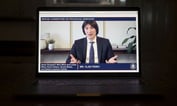If the world’s biggest economy is really on the upswing, then why are America’s banks stockpiling a record amount of ultrasafe bonds?
After all, jobs are back, the Federal Reserve is close to raising interest rates again and growth has perked up after a sluggish first half. But instead of ramping up lending to keep up with deposits, banks are plowing into U.S. government and related debt at the fastest clip since 2014.
The easy answer, of course, has to do with post-crisis financial regulations, which were designed to curb risk-taking and have compelled banks to hold more high-quality assets. Yet in many ways, the buildup reflects a more worrying sign. In the past year, more loan officers at large and midsize banks have tightened credit to businesses than at any time since 2009, when the U.S. was still reeling from the housing bust. Americans are also saving more rather than taking on extra debt, damping demand for new loans.
Though it’s hard to say whether that means the seven-year-long U.S. expansion may be closer to an end than the upbeat data suggest, the demand for bonds is welcome news for investors buffeted by the biggest monthly selloff since 2010.
“Banks continue to buy Treasuries as we move further through the economic cycle,” said Jeff Caughron, chief operating officer at Oklahoma City-based Baker Group, which advises community banks with over $45 billion in investments. And there are just “fewer good loans out there to be made.”
That may help contain the backup in Treasury yields as rates rise and foreign demand slows.
Global Selloff
Yields on the U.S. 10-year note have climbed about a half-percentage point since falling to an all-time low of 1.318 percent in July. They were about 1.84 percent today. Losses have accelerated as bonds globally head for their worst month in about six years on speculation major central banks are moving closer to reining in stimulus.
But with banks finding fewer opportunities to lend, it’s raising deeper questions about the prospects for future economic growth.
Commercial banks in the U.S. have amassed $90 billion of Treasuries and non-mortgage debt from federal agencies this year alone, bringing the total to $754 billion, according to data compiled by the Fed. Including federally guaranteed mortgage-backed securities, banks now own $2.4 trillion of government bonds, which would be the most since the central bank began compiling data in 1973.
The five biggest lenders — Wells Fargo & Co., JPMorgan Chase & Co., Bank of America Corp., Citigroup Inc. and U.S. Bancorp — held a combined $206 billion of government debt at the end of the second quarter, according to the latest available filings. That’s a 74 percent increase over the past three years.
Banks aren’t lending more because the economy “isn’t growing as fast as we’d like it to grow,” said Paul Miller, a bank analyst at FBR Capital Markets & Co. “Banks are only able to take a certain amount of risk.”
Bank of America, the only big lender to provide supplemental data on its investments through September, has doubled its “available-for-sale” holdings in government debt to $45 billion over the past six months. AFS excludes securities used in daily trading and those intended to be held until maturity. Citigroup has also increased its exposure in a big way, boosting its holdings to $126 billion at the end of June, the most since at least 1999.
What’s more, banking organizations across America have boosted the stakes they plan to hold to maturity (meaning they can keep those investments on their books at the price they paid and not worry about market fluctuations) to almost a half-trillion dollars in the second quarter, based on New York Fed data. At the end of 2013, the figure was just $50 billion.
A big reason banks are funneling so much money into safe assets is that deposit growth is outstripping loan demand. For the biggest lenders, deposits increased by 6.7 percent to $5.2 trillion in the third quarter from a year earlier, exceeding loan growth by a full percentage point.
Few Alternatives







 October 31, 2016 at 05:41 AM
October 31, 2016 at 05:41 AM











 Copyright © 2024 ALM Global, LLC. All Rights Reserved.
Copyright © 2024 ALM Global, LLC. All Rights Reserved.